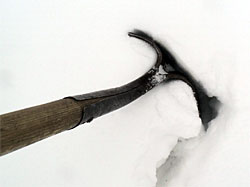|
 |
March 5, 2013 |
|
Electric Equipment Initiative Paul Carter, CGCS, Bear Trace at Harrison Bay, Harrison, TN:
 "How great for the environment would it be to be able to maintain the golf course without burning a single drop of fuel? Well, that may seem like a dream but it is one that we are going to chase at Harrison Bay. In an effort to reduce our impact on the environment through the emission of carbon emitted by our current gasoline engines we are converting the majority of our golf course maintenance equipment to a fully electric battery powered fleet. 
It has taken a while to get the project off the ground but we are getting very close to seeing it be a reality. The equipment we chose for the project is the Jacobsen Eclipse 322 triplex mower for greens, tees, and approaches, the Smithco Super Star 48 volt bunker rake, the Tru Turf R52 greens roller, the Toro Workman MDE, and the Club Car Carry All Turf II. These units will allow us on many days to maintain our golf course without burning a single drop of fuel or emitting a single pound of point source carbon emission. The goal of the whole project.
We have taken delivery of a couple pieces of equipment last week which have already been placed into service and are operating beyond our expectations." |
 |
|
Step on up... Craig DeJong, Hendersonville Country Club, Hendersonville, NC:
 "Our staff has taken on an additional project this winter. The seven stairways throughout the course, leading to various greens and tees, are beginning to degrade quickly. They are also inconsistent in the material used to originally build them.
Visit Craig's blog at hccgcgd.blogspot.com |
 |
|
Mute Swans... Rick Tegtmeier, CGCS, Des Moines Golf & Country Club, West Des Moines, IA:
 "Our resident Mute Swans are going to have a new friend soon. I have located a female mute swan that is a couple of years old. She is from Wisconsin and her owner lives in Illinois. I will be getting her next week so she can become the companion to our lone male. So we should have 2 pairs of Mute Swans to start our spring season. Hopefully one of the pair will nest and produce some cygnets. Above right is a photo of one of our pairs. |
 |
|
Here we go again? Mark Kienert, CGCS, Bull's Eye Country Club, Wisconsin Rapids, WI:
 "Curiosity got the best of me. I knew I would find ice once again on putting surfaces, but the question was "how much?" So I grabbed my snow shoes from my garage, bolted them on my feet and went for a walk. (I had forgotten how tiring walking in the snow could be so I managed a little exercise to boot.)
Point confirmed, ice present! (But it is present like this every year.) I'm guess estimating that the ice layer formed the 10th of February when all day rains turned my driveways into a sheet of ice. (For some reason our onsite weather station did not record any rain for that day and needs to be checked.)
What we have going for us this year is the benefit of a late season deep tine aerification coupled with a second solid tine aerification and a heavy topdressing to protect the plants. The aerifications will improve surface drainage and oxygen exchange. The topdressing will protect the crowns of the plants. Also I allowed the greens to "shag out" like the winter coat on horse to allow the plant additional leaf surface to maximize food production and storage. (Plant health.) Also, the extensive work regrassing putting greens that thinned out or succumbed to last years drought should pay dividends too. Your greens were as healthy heading into winter as I have seen them for some time. |
 |
|
A pretty good day... Michael Stachowicz, Turf Specialist, National Park Service, Washington, DC:  "The day I got fired was not the the worst day in my life. In fact it was a pretty good day. Obviously the view gets rosier with time, but I can safely say that that day was not nearly as bad as I thought it was going to be. And I know that I am not the only one who has had that feeling.
Pressure had been mounting at the club for two or three years when the then club president formed a second green committee in addition to the one I had been answering to for the prior six years. Prior presidents had dealt with the loud 2% they way they should be: they were respectfully dismissed. This president probably never thought what forming a second green committee (cleverly called the Golf Course Conditioning, Aesthetics, and Playability Committee) to give the complainers a voice would do to the club and to my career. I know he never thought something bad would happen because I am memorialized in the centennial history book's presidential message as a visionary for the direction of the club.
As the news was delivered, I felt this great sense of relief. Anyone who has been in this business long enough knows someone who has expressed this same feeling at getting fired. It is the scary and wonderful end of an abusive relationship. Your paradigm changes, all of a sudden things that were clouded by the fog of war brought on by summer comes into focus as the fog clears. Health, family, future, opportunity all come to the forefront. The fucked up situation that you were trying to protect your staff and your family from is gone. Like that. Not your problem anymore. Finding another job seems like an easy task compared to the hornet's nest obstacle course with a moving finish line that you were attempting to conquer everyday at work. |
 |
|
Winter pruning... Steve Cook, CGCS MG, Oakland Hills Country Club, Bloomfield Hills, MI:
 "Oak Wilt is a vascular disease and it attacks all oaks. The disease plugs the water conducting (or sapwood) tissue, interrupting the flow of water, leading to wilting and sometimes death. Fungicides can be injected to protect the tree, but as with any chemical treatment, the results can be inconsistent. |
 |
|
The Yearly Haircut... John Slade, Laurel Creek Country Club, Mt. Laurel, NJ:
 "One of the things the crew can count on each winter is the annual pruning of our wetlands crossings on #2, 8, 12, and 14. According to the conditions of our permit, we may only do this trimming during January and February, and only hand tools can be used. Hey, who says nobody notices? Check out this nice note John received this past weekend (love the 'gulag workers' reference!): 
|
 |
|
About our Blog Aggregator: Many superintendents are now hosting private blogs to better communicate with their golfers and/or members. Beyond local weather and course conditions, there is a great deal of information about projects, methodologies and techniques that would be of value to other superintendents — hence our Turf Blog Aggregator. As every blogger struggles occasionally with content, we also include posts intended to educate golfers about turf maintenance for others to use as a template for their own blogs. Miss any previous issues of TBA? You can find them all here. |




